China Automotive Gesture Interaction Development Research Report,2022-2023
Vehicle gesture interaction research: in 2022, the installations rocketed by 315.6% year on year.
China Automotive Gesture Interaction Development Research Report, 2022-2023 released by ResearchInChina analyzes and studies four aspects: gesture interaction technology, benchmarking vehicle gesture interaction solutions, gesture interaction industry chain, and gesture interaction solution providers.
1. In 2022, the installations of vehicle gesture recognition functions soared by 315.6% on an annual basis.
Accompanied by iterative upgrade of intelligent cockpit technology, cockpit services are evolving from passive intelligence to active intelligence, and the human-computer interaction mode is also shifting from single-modal to multi-modal interaction. In this trend, vehicle gesture interaction functions enjoy a boom. In 2022, gesture recognition (standard configuration) was installed in 427,000 passenger cars in China, a year-on-year spurt of 315.6%, with installation rate up to 2.1%, 1.6 percentage points higher than 2021.
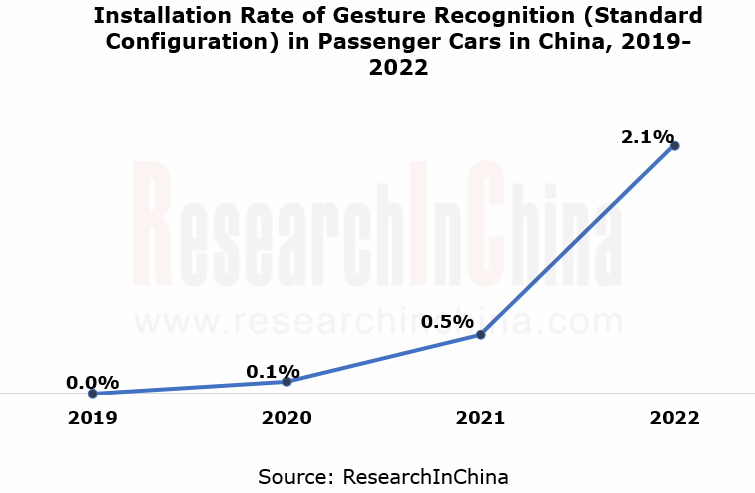
By brand, in 2022 Changan Automobile boasted the highest gesture recognition installation rate, up to 33.0%, 13.1 percentage points higher than 2021. In terms of models, in 2022, Changan Automobile had a total of 6 models (e.g., UNI-V, CS75 and UNI-K) equipped with gesture recognition as a standard configuration, 5 models more than in 2021.
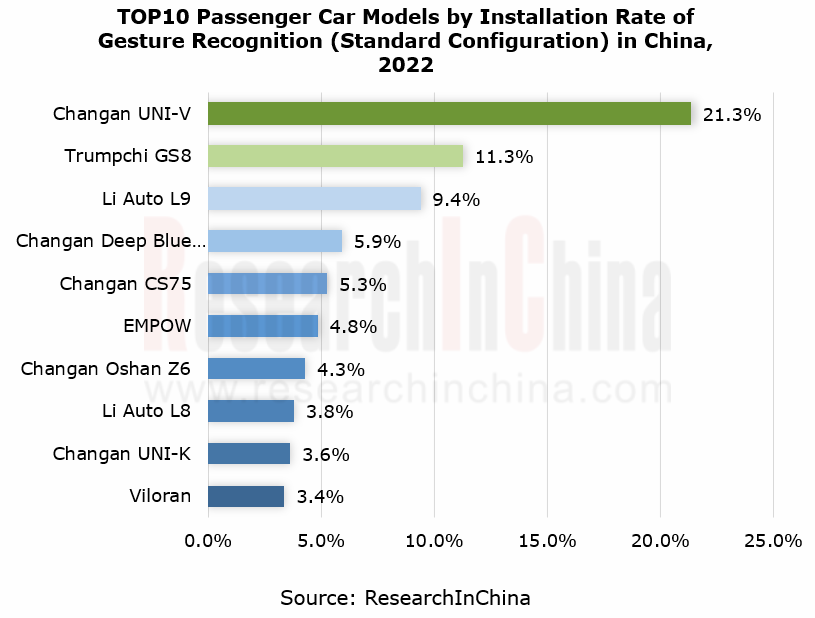
The gesture recognition feature of Changan UNI-K adopts a 3D ToF solution, enabling such functions as song switch and navigation activation. The specific gestures are: swipe the palm horizontally to left/right for playing the previous/next song; make a finger heart for navigating back home; thumb up for navigating to the workplace.
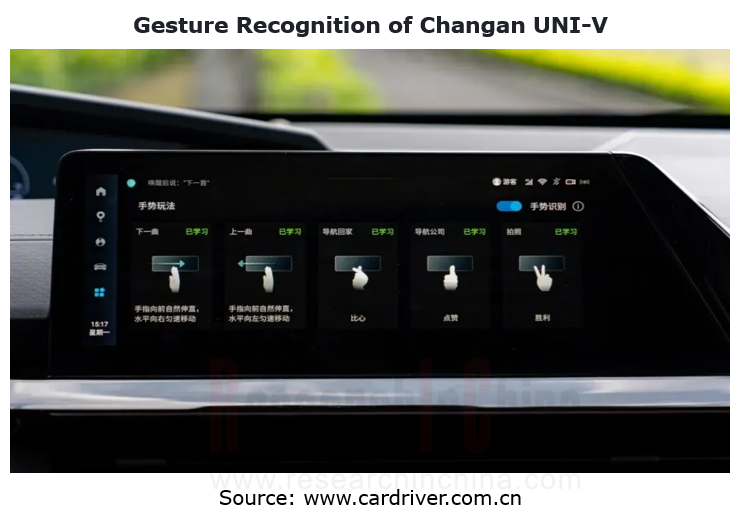
2. The control scope of gesture recognition is extending from software to hardware, and from the inside to the outside of cars.
As gesture interaction technology gains popularity and finds application in ever more scenarios, vehicle gesture interaction also springs up. At present, automakers are working hard on layout of cockpit interaction functions. Gesture controlled functions have increased from initially in-vehicle infotainment system features (e.g., phone call, media volume and navigation), to body hardware and safety systems (e.g., windows/sunroof/sunshades, doors, and driving).
In addition, manufacturers also make efforts to develop exterior gesture control technology. One example is WEY Mocha that has allowed for gesture control over ignition, forward/backward movement, stop, and flameout outside the car. In the future, gesture recognition will no longer be limited to occupants, and will gradually cover actions of passers-by outside the car, for instance, recognizing command gestures of traffic police on road or gestures made by cyclists around the car.
3. Six gesture recognition technology routes.
From the perspective of technology route, gesture recognition technologies are led by 3D camera based structured light, ToF, stereo imaging, radar-based millimeter wave, ultrasonics, and bioelectricity-based myoelectricity.

In current stage, 3D camera based gesture sensing prevails among vehicle gesture recognition technology routes. The technology route consists of 3D camera and control unit. Composed of camera, infrared LED and sensor, the 3D camera is used to capture hand movements, and then recognize the type of gestures via corresponding image processing algorithms and issue relevant instructions. The 3D camera based technology route can be subdivided into structured light, ToF and stereo vision.
1. Structured light technology refers to a solution where the light with coded information is projected onto the human body, the infrared sensor collects the reflected structural pattern, and finally the processor builds a 3D model. With benefits of mature hardware, high recognition accuracy and high resolution, it is applicable to close-range scenarios within 10 meters. The gesture recognition carried by Neta S rolled out in July 2022 is a structured light solution.
The in-cabin gesture recognition sensor of Neta S is located above the interior rearview mirror. It can recognize 6 gestures, including: swipe the palm back and forth to adjust the light transmittance of the sunroof; make the "shh" sign for the silent mode; rotate a finger clockwise/counterclockwise to adjust the volume; move the palm to left and right to switch audio and video programs; make the "V" sign to take selfies in the car; thumb up to save favorite programs.
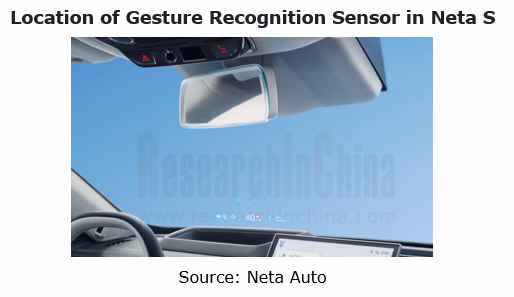
2. ToF technology, namely, time-of-flight (ToF) based ranging, is enabled with 3D images constructed by the underlying photosensitive elements. It can obtain effective and real-time depth information within 5 meters. With the applicability to a wider range of scenarios, it acquires effective depth of field information regardless of whether the ambient light is strong (e.g., sunlight) or weak. The gesture recognition solutions installed in production models like BMW iX, Li Auto L9 and new ARCFOX αS HI Edition are all ToF solutions.
The in-cabin gesture recognition sensor of BMW iX lies at the dome light above the center console screen. It can recognize 8 gestures, including:
① swipe hand to left and right to reject phone call/close the pop-up;
② point the index finger back and forth to answer phone call/confirm the pop-up;
③ rotate the index finger clockwise to turn the volume up or zoom in on the navigation map;
④ rotate the index finger counterclockwise to turn the volume down or zoom out on the navigation map;
⑤move a fist with thumb extended to left right back and forth to play the previous/next song;
⑥ point the index and middle fingers extended into the display to perform individually assignable gesture;
⑦ stretch out all five fingers, make a fist and then stretch out all five fingers again to perform individually assignable gesture;
⑧ bring thumb and index finger together and swipe the hand to the right or left for a view around the car (requiring the car to pack the automated parking assist system PLUS).
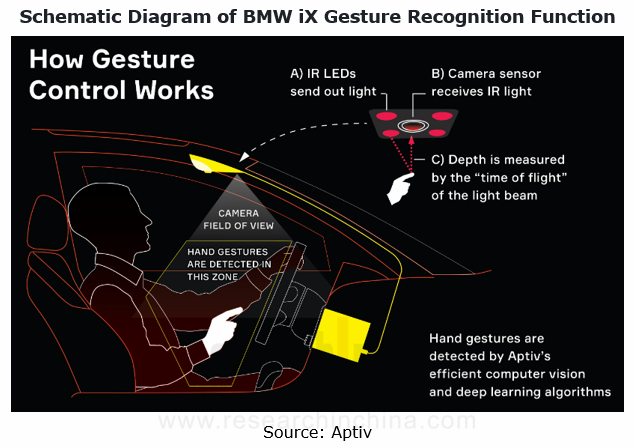
To ensure gesture recognition and control by occupants, Li Auto L9 has gesture recognition sensors installed in the fore cabin and rear cabin. The fore cabin sensor is located above the interior rearview mirror, and the rear one lies above the rear entertainment screen.
The fore cabin sensor can recognize 2 gestures, including:
①point towards windows/sunroof/sunshades to control (combined with voice interaction capability);
②make a fist and hold, and swipe up and down on the play page to adjust the volume.
The rear cabin sensor can recognize 7 gestures, including: ①stretch out all five fingers and place the inner side of elbow on the armrest for 2 seconds to activate the gesture control function; ②stretch out all five fingers and swipe the hand down to turn on the screen; ③stretch out all five fingers and swipe the hand to move the cursor; ④stretch out all five fingers and make a fist to spot the icon; ⑤stretch out all five fingers, make a fist and hold, and move the hand to share the content on the rear entertainment screen to the front display; ⑥stretch out all five fingers, make a fist and hold, and swipe the hand on the play page to left and right to adjust the play progress; ⑦stretch out all five fingers and swipe the hand up to exit the current content.
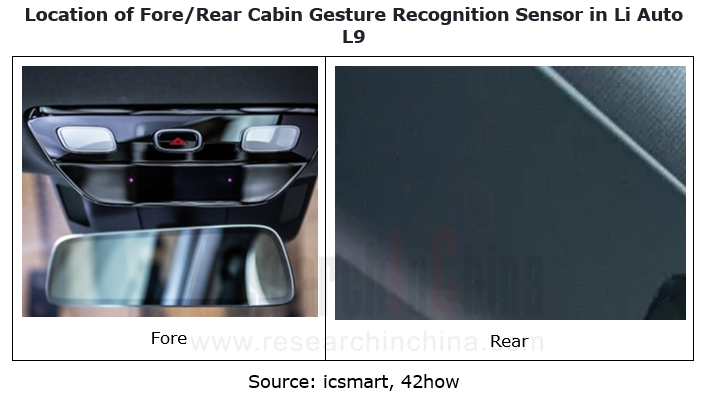
3. Stereo imaging technology based on the parallax principle is enabled with 3D geometric information of objects that is obtained from multiple images. This technology is a cost-effective solution posing low requirements for hardware and needing no additional special device. The gesture recognition solution carried by the Mercedes-Benz EQS launched in May 2022 is a stereo imaging solution.
The in-cabin gesture recognition sensor of Mercedes-Benz EQS is located at the reading light on the roof, and can recognize 3 gestures, including:
① make the "V" sign to call up favorites;
②swipe hand back and forth under the interior rearview mirror to control the sunroof;
③swipe hand toward the inside of the car to automatically close doors (requiring optional four-door electric switches).
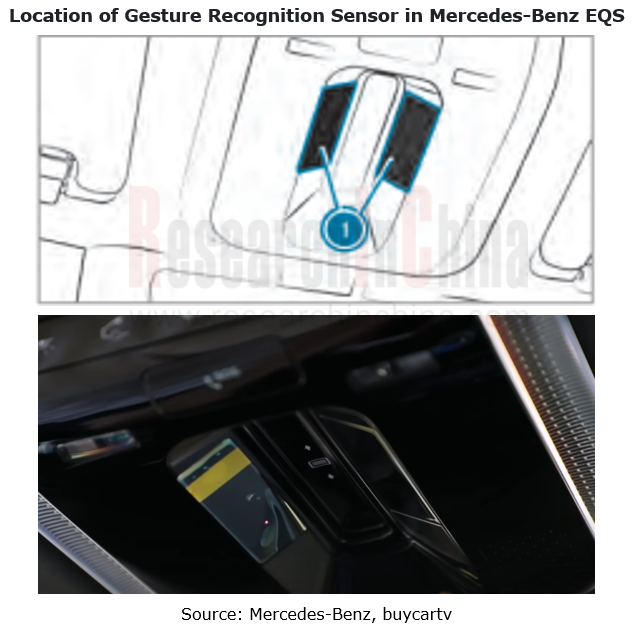
Currently gesture recognition technologies such as radar-based millimeter wave, ultrasonics, and bioelectricity-based myoelectricity have yet to be used widely in in-cabin gesture recognition functions. Compared with conventional vision-based gesture recognition, these technologies still have some limitations and pose challenges.
1. Radar is a radio wave sensor that enables accurate detection of the position and movements of hands even in the presence of obstacles.
In 2020, Ainstein, the American subsidiary of Muniu Technology, together with ADAC Automotive established a joint venture brand - RADAC. At the CES 2020, Ainstein introduced a radar–based vehicle gesture recognition solution. The gesture recognition sensor in this solution lies on the top of the tailgate, allowing users to open the door by swiping hand to left and right.
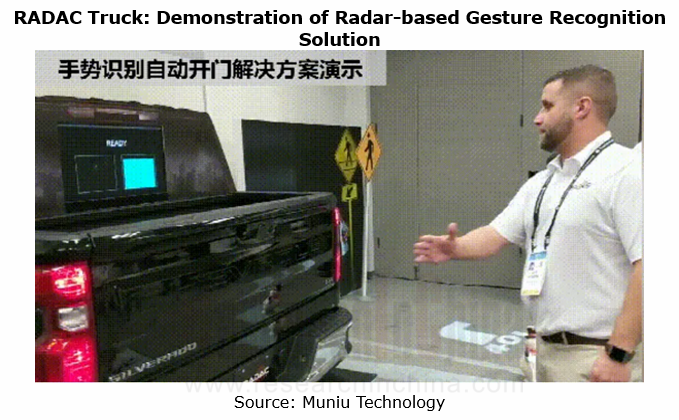
2. Ultrasonic radar. In February 2020, DS showcased the Aero Sport Lounge concept car at the Geneva International Motor Show. Integrating Leap Motion and Ultrahaptics technologies, this car can easily recognize and understand every gesture made by occupants, and give haptic feedback to them through the stereo ultrasonic waves emitted by the micro-speaker.
The in-cabin gesture recognition and ultrasonic feedback sensor of DS Aero Sport Lounge is located at the center armrest of the car, and can recognize 5 gestures, including:
①adjust in-cabin temperature and blowing velocity;
②adjust tracks and volume;
③process navigation/map, including new route settings;
④answer/reject phone calls;
⑤switch menu functions.
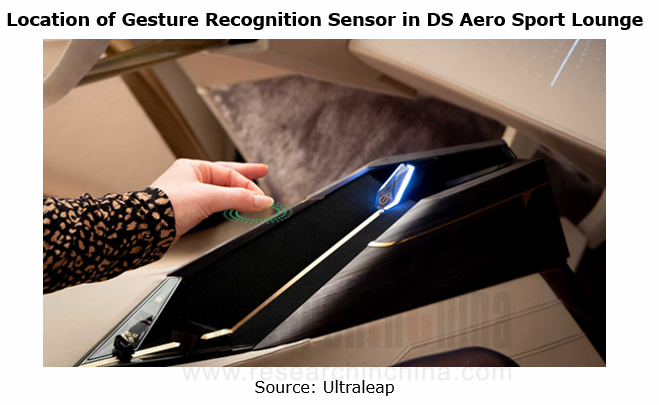
3. Bioelectricity refers to the electric signals generated by human muscular movements. Bioelectric sensors can recognize gestures and movements by measuring these signals. At present, the bioelectricity-based myoelectric gesture recognition technology is more used to control external devices and interaction interfaces, such as prosthetics, virtual reality and gaming devices. Thalmic Labs, a Canadian company dedicated to developing smart gesture control products, introduced the first wearable device, the MYO armband, which uses myoelectricity technology. The eight myoelectric sensors embedded in the armband record the electric signals of arm muscles, and recognize different gestures by analyzing these signals. In the actual application, users can control drones, computers, smartphones and other electronic devices through the Bluetooth connect of MYO. There are no vehicle use cases at present.
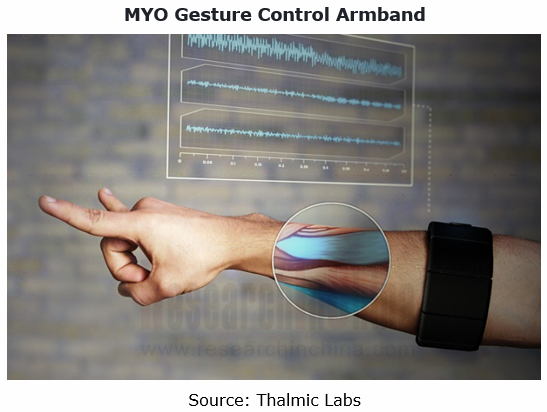
Automotive 4D Radar Industry Research Report 2025
4D radar research: From "optional" to "essential," 4D radar's share will exceed 50% by 2030.
1. 4D imaging radar has transformed from an "optional" to a "must-have" sensor.
4D radar adds the detecti...
China Automotive Multimodal Interaction Development Research Report, 2025
Research on Automotive Multimodal Interaction: The Interaction Evolution of L1~L4 Cockpits
ResearchInChina has released the "China Automotive Multimodal Interaction Development Research Report, 2025"...
Automotive Vision Industry Report, 2025
Automotive Vision Research: Average Camera Installation per Vehicle Reaches 5.2 Units, and Front-View Tricam Installation Exceeds 1.2 Million Sets.
From January to September 2025, the total installa...
Automotive Infrared Night Vision System Research Report, 2025
Automotive night vision research: The rise of infrared AEB, with automotive infrared night vision experiencing a 384.7% year-on-year increase from January to September.
From January to September 2025...
New Energy Vehicle Cross-Domain (Electric Drive System and Powertrain Domain) Integration Trend Report 2025-2026
Electric Drive and Powertrain Domain Research: New technologies such as three-motor four-wheel drive, drive-brake integration, and corner modules are being rapidly installed in vehicles.
Electric dri...
Analysis on Desay SV and Joyson Electronic's Electrification, Connectivity, Intelligence and Sharing, 2025
Research on Desay SV and Joyson Electronic: Who is the No.1 Intelligent Supplier?
Both Desay SV and Joyson Electronic are leading domestic suppliers in automotive intelligence. "Analysis on Desay SV ...
OEMs and Tier 1 Suppliers' Cost Reduction and Efficiency Enhancement Strategy Analysis Report, 2025
ResearchInChina released the "OEMs and Tier 1 Suppliers' Cost Reduction and Efficiency Enhancement Strategy Analysis Report, 2025", summarizing hundreds of cost reduction strategies to provide referen...
Automotive Fixed Panoramic Sunroof and Smart Roof Research Report, 2025
With the intelligent application of car roofs as the core, this report systematically sorts out a series of new products such as fixed panoramic sunroof/openable sunroof, ceiling screen, roof ambient ...
Automotive-Grade Power Semiconductor and Module (SiC, GaN) Industry Research Report, 2025
SiC/GaN Research: Sales volume of 800V+ architecture-based vehicles will increase more than 10 times, and hybrid carbon (SiC+IGBT) power modules are rapidly being deployed in vehicles.
Sales volume o...
Cockpit Agent Engineering Research Report, 2025
Cockpit Agent Engineering Research: Breakthrough from Digital AI to Physical AI
Cockpit Agent Engineering Research Report, 2025 starts with the status quo of cockpit agents, summarizes the technical ...
Prospective Study on L3 Intelligent Driving Technology of OEMs and Tier 1 Suppliers, 2025
L3 Research: The Window of Opportunity Has Arrived - Eight Trends in L3 Layout of OEMs and Tier 1 Suppliers
Through in-depth research on 15 OEMs (including 8 Chinese and 7 foreign OEMs) and 9 Tier 1 ...
China Commercial Vehicle IoV and Intelligent Cockpit Industry Research Report 2025
Commercial Vehicle IoV and Cockpit Research: The Third Wave of Passenger Car/Commercial Vehicle Technology Integration Arrives, and T-Box Integrates e-Call and 15.6-inch for Vehicles
I. The third wav...
Intelligent Vehicle Electronic and Electrical Architecture (EEA) and Technology Supply Chain Construction Strategy Research Report, 2025
E/E Architecture Research: 24 OEMs Deploy Innovative Products from Platform Architectures to Technical Selling Points
According to statistics from ResearchInChina, 802,000 passenger cars with domain...
Research Report on Intelligent Vehicle Cross-Domain Integration Strategies and Innovative Function Scenarios, 2025
Cross-Domain Integration Strategy Research: Automakers' Competition Extends to Cross-Domain Innovative Function Scenarios such as Cockpit-Driving, Powertrain, and Chassis
Cross-domain integration of ...
China Autonomous Driving Data Closed Loop Research Report, 2025
Data Closed-Loop Research: Synthetic Data Accounts for Over 50%, Full-process Automated Toolchain Gradually Implemented
Key Points:From 2023 to 2025, the proportion of synthetic data increased from 2...
Automotive Glass and Smart Glass Research Report, 2025
Automotive Glass Report: Dimmable Glass Offers Active Mode, Penetration Rate Expected to Reach 10% by 2030
ResearchInChina releases the Automotive Glass and Smart Glass Research Report, 2025. This r...
Passenger Car Brake-by-Wire (BBW) Research Report, 2025
Brake-by-Wire: EHB to Be Installed in 12 Million Vehicles in 2025
1. EHB Have Been Installed in over 10 Million Vehicles, A Figure to Hit 12 Million in 2025.
In 2024, the brake-by-wire, Electro-Hydr...
Autonomous Driving Domain Controller and Central Computing Unit (CCU) Industry Report, 2025
Research on Autonomous Driving Domain Controllers: Monthly Penetration Rate Exceeded 30% for the First Time, and 700T+ Ultrahigh-compute Domain Controller Products Are Rapidly Installed in Vehicles
L...